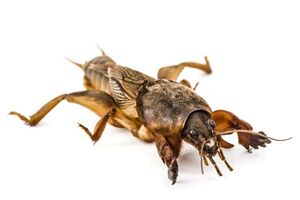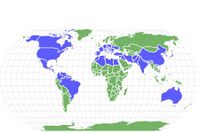Mole cricket
Mole crickets are fossorial insects belonging to the order Orthoptera and family Gryllotalpidae, spending most of their life underground. [1] Mole crickets encompass seven genera and contain about 100 species worldwide. [2] Their specialized forelegs allow them to dig and construct burrows in the soil. Their burrows are carefully constructed and serve a variety of purposes. [1]

| |
| Kingdom | Animalia |
|---|---|
| Phylum | Arthropoda |
| Class | Insecta |
| Order | Orthoptera |
| Family | Gryllotalpidae |
Anatomy
Different species have slight variations in anatomy. The mole cricket possesses two pairs of legs that resemble a cricket as well as a pair of forelegs that closely resemble those of moles and are specialized for digging burrows. Their skin is able to prevent adhesion by moist soil during the digging process because of a thin layer of down on the mole crickets' body. [5] Antennae serve as the mole cricket's main olfactory organ and also serve as gustatory and mechanoreceptors. [6]Kostromytska, Olga, Michael E. Scharf, and Eileen A. Buss. “Types and Functions of Mole Cricket (Orthoptera: Gryllotalpidae) Antennal and Palpal Sensilla.” Florida Entomologist 98, no. 2 (2015): 593–605. https://doi.org/10.1653/024.098.0232.</ref> Further, these antennae aid in warning mole crickets of approaching danger. The mole cricket's safety is further assured by its brown hue which allows it to blend into the soil. Most mole crickets species possess two pairs of wings that allow adults to fly short distances.john cricket ref goes here However, some species of mole cricket, like the shortwinged mole cricket do not grow wings large enough to support flight. [7] The body of the mole cricket can be broken down into three main parts which include the head, thorax, and abdomen. john cricket ref goes here
Habitat and Distribution

Mole crickets live most of their life in the soil in burrows that average about 1/2 inch in diameter. [9] Various species of mole crickets can be found on every continent except Antarctica. They can be found in any location with moist, loose soil. [8] However, they show a preference for sandy soil. They can often be found within the vicinity of meadows and fields, specifically of corn and barley. [5] Mole crickets are rarely seen by people because of their underground habitat and nocturnal tendencies. [9]
Diet
Life Cycle & Reproduction
Pest Control
References
- ↑ Jump up to: 1.0 1.1 Endo, Chihiro. “The Underground Life of the Oriental Mole Cricket: An Analysis of Burrow Morphology.” Journal of Zoology 273, no. 4 (2007): 414–20. https://doi.org/10.1111/j.1469-7998.2007.00345.x.
- ↑ Ingrisch, Sigfrid, and D.C.F. Rentz. “Orthoptera: Grasshoppers, Locusts, Katydids, Crickets.” Essay. In Encyclopedia of Insects, Seconded., 732–43. Academic Press, 2009.
- ↑ “Mole Cricket Control in Lawns and Turf.” ngturf.com, April 2022. https://ngturf.com/mole-cricket-control-in-lawns-and-turf/.
- ↑ “Gryllotalpidae.” itis.gov, n.d. https://www.itis.gov/servlet/SingleRpt/SingleRpt?search_topic=TSN&search_value=102369#null.
- ↑ Jump up to: 5.0 5.1 Kidd, John. “On the Anatomy of the Mole-Cricket.” Philosophical Transactions of the Royal Society of London 115 (1825): 203–46. https://doi.org/10.1098/rstl.1825.0012.
- ↑ Cite error: Invalid
<ref>tag; no text was provided for refs namedantenna - ↑ “Basic Biology of Mole Crickets.” entnemdept.ufl.edu, n.d. https://entnemdept.ufl.edu/molecrickets/MCRI0201.HTM.
- ↑ Jump up to: 8.0 8.1 “Mole Cricket.” azanimals.com, 2021. https://a-z-animals.com/animals/mole-cricket/.
- ↑ Jump up to: 9.0 9.1 “Mole Cricket.” texasinsects.tamu.edu, n.d. http://texasinsects.tamu.edu/mole-cricket/.